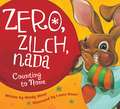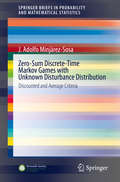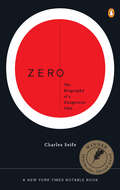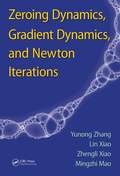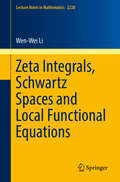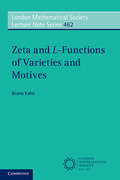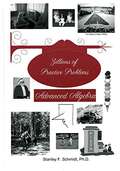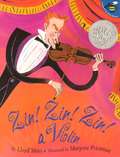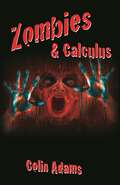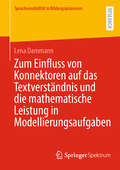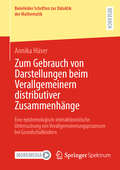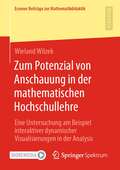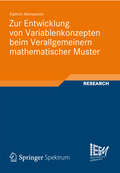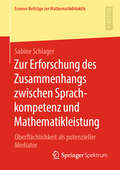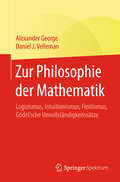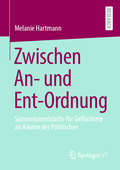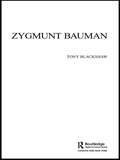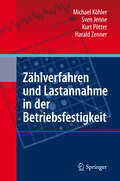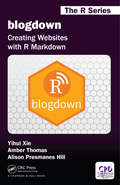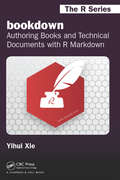- Table View
- List View
Zero! The Number That Almost Wasn't
by Sarah AlbeeHow did math work before zero existed? A STEM nonfiction book that unpacks a fascinating history of a number we can&’t imagine our current world without.From place value to being created and destroyed before being created again, zero has had quite a journey. Respected children&’s author and consummate researcher Sarah Albee lays out the history of zero alongside the complications that initially hampered its development, including Western imperialism.A riveting nonfiction kids book with a playful feel, Zero! unravels a complicated history in tremendous detail.
Zero, Zilch, Nada: Counting to None
by Wendy UlmerHarry is excited! Today is the first day at his new job at the 4 Color Balloon Factory. Harry loves balloons almost more than anything! When Mr. Huffy, his new boss, tells him to blow up 100 balloons for Mrs. Doopido's birthday party, Harry can't wait to get started. But when Harry wants to make sure he has the correct number of balloons for the birthday party, counting the balloons gets confusing. And no matter what he does, the number still comes out wrong. What is the best way to count to 100?
Zero-Sum Discrete-Time Markov Games with Unknown Disturbance Distribution: Discounted and Average Criteria (SpringerBriefs in Probability and Mathematical Statistics)
by J. Adolfo Minjárez-SosaThis SpringerBrief deals with a class of discrete-time zero-sum Markov games with Borel state and action spaces, and possibly unbounded payoffs, under discounted and average criteria, whose state process evolves according to a stochastic difference equation. The corresponding disturbance process is an observable sequence of independent and identically distributed random variables with unknown distribution for both players. Unlike the standard case, the game is played over an infinite horizon evolving as follows. At each stage, once the players have observed the state of the game, and before choosing the actions, players 1 and 2 implement a statistical estimation process to obtain estimates of the unknown distribution. Then, independently, the players adapt their decisions to such estimators to select their actions and construct their strategies. This book presents a systematic analysis on recent developments in this kind of games. Specifically, the theoretical foundations on the procedures combining statistical estimation and control techniques for the construction of strategies of the players are introduced, with illustrative examples. In this sense, the book is an essential reference for theoretical and applied researchers in the fields of stochastic control and game theory, and their applications.
Zero: The Biography of a Dangerous Idea
by Charles SeifeThe Babylonians invented it, the Greeks banned it, the Hindus worshiped it, and the Church used it to fend off heretics. Now it threatens the foundations of modern physics. For centuries the power of zero savored of the demonic; once harnessed, it became the most important tool in mathematics. For zero, infinity's twin, is not like other numbers. It is both nothing and everything. In Zero, Science Journalist Charles Seife follows this innocent-looking number from its birth as an Eastern philosophical concept to its struggle for acceptance in Europe, its rise and transcendence in the West, and its ever-present threat to modern physics. Here are the legendary thinkers—from Pythagoras to Newton to Heisenberg, from the Kabalists to today's astrophysicists—who have tried to understand it and whose clashes shook the foundations of philosophy, science, mathematics, and religion. Zero has pitted East against West and faith against reason, and its intransigence persists in the dark core of a black hole and the brilliant flash of the Big Bang. Today, zero lies at the heart of one of the biggest scientific controversies of all time: the quest for a theory of everything. .
Zeroing Dynamics, Gradient Dynamics, and Newton Iterations
by Yunong Zhang Lin Xiao Zhengli Xiao Mingzhi MaoNeural networks and neural dynamics are powerful approaches for the online solution of mathematical problems arising in many areas of science, engineering, and business. Compared with conventional gradient neural networks that only deal with static problems of constant coefficient matrices and vectors, the authors’ new method called zeroing dynamics solves time-varying problems. Zeroing Dynamics, Gradient Dynamics, and Newton Iterations is the first book that shows how to accurately and efficiently solve time-varying problems in real-time or online using continuous- or discrete-time zeroing dynamics. The book brings together research in the developing fields of neural networks, neural dynamics, computer mathematics, numerical algorithms, time-varying computation and optimization, simulation and modeling, analog and digital hardware, and fractals.The authors provide a comprehensive treatment of the theory of both static and dynamic neural networks. Readers will discover how novel theoretical results have been successfully applied to many practical problems. The authors develop, analyze, model, simulate, and compare zeroing dynamics models for the online solution of numerous time-varying problems, such as root finding, nonlinear equation solving, matrix inversion, matrix square root finding, quadratic optimization, and inequality solving.
Zeros of Polynomials and Solvable Nonlinear Evolution Equations
by Francesco CalogeroReporting a novel breakthrough in the identification and investigation of solvable and integrable nonlinearly coupled evolution ordinary differential equations (ODEs) or partial differential equations (PDEs), this text includes practical examples throughout to illustrate the theoretical concepts. Beginning with systems of ODEs, including second-order ODEs of Newtonian type, it then discusses systems of PDEs, and systems evolving in discrete time. It reports a novel, differential algorithm which can be used to evaluate all the zeros of a generic polynomial of arbitrary degree: a remarkable development of a fundamental mathematical problem with a long history. The book will be of interest to applied mathematicians and mathematical physicists working in the area of integrable and solvable non-linear evolution equations; it can also be used as supplementary reading material for general applied mathematics or mathematical physics courses.
Zeta Functions of Graphs A Stroll through the Garden
by Audrey TerrasGraph theory meets number theory in this stimulating book. Ihara zeta functions of finite graphs are reciprocals of polynomials, sometimes in several variables. Analogies abound with number-theoretic functions such as Riemann/Dedekind zeta functions. For example, there is a Riemann hypothesis (which may be false) and prime number theorem for graphs. Explicit constructions of graph coverings use Galois theory to generalize Cayley and Schreier graphs. Then non-isomorphic simple graphs with the same zeta are produced, showing you cannot hear the shape of a graph. The spectra of matrices such as the adjacency and edge adjacency matrices of a graph are essential to the plot of this book, which makes connections with quantum chaos and random matrix theory, plus expander/Ramanujan graphs of interest in computer science. Pitched at beginning graduate students, the book will also appeal to researchers. Many well-chosen illustrations and diagrams, and exercises throughout, theoretical and computer-based.
Zeta Integrals, Schwartz Spaces and Local Functional Equations (Lecture Notes in Mathematics #2228)
by Wen-Wei LiThis book focuses on a conjectural class of zeta integrals which arose from a program born in the work of Braverman and Kazhdan around the year 2000, the eventual goal being to prove the analytic continuation and functional equation of automorphic L-functions. Developing a general framework that could accommodate Schwartz spaces and the corresponding zeta integrals, the author establishes a formalism, states desiderata and conjectures, draws implications from these assumptions, and shows how known examples fit into this framework, supporting Sakellaridis' vision of the subject. The collected results, both old and new, and the included extensive bibliography, will be valuable to anyone who wishes to understand this program, and to those who are already working on it and want to overcome certain frequently occurring technical difficulties.
Zeta and L-Functions of Varieties and Motives (London Mathematical Society Lecture Note Series #462)
by Bruno KahnThe amount of mathematics invented for number-theoretic reasons is impressive. It includes much of complex analysis, the re-foundation of algebraic geometry on commutative algebra, group cohomology, homological algebra, and the theory of motives. Zeta and L-functions sit at the meeting point of all these theories and have played a profound role in shaping the evolution of number theory. This book presents a big picture of zeta and L-functions and the complex theories surrounding them, combining standard material with results and perspectives that are not made explicit elsewhere in the literature. Particular attention is paid to the development of the ideas surrounding zeta and L-functions, using quotes from original sources and comments throughout the book, pointing the reader towards the relevant history. Based on an advanced course given at Jussieu in 2013, it is an ideal introduction for graduate students and researchers to this fascinating story.
Zillions Of Practice Problems Advanced Algebra
by Stanley F. SchmidtExtra practice problems for Life of Fred Advanced Algebra.
Zin! Zin! Zin! A Violin
by Lloyd MossUsing evocative poetic language, the author describes ten instruments coming on stage and performing, to the delight of the audience. [This text is listed as an example that meets Common Core Standards in English language arts for K-1 at http://www.corestandards.org.]
Zombies and Calculus
by Colin AdamsA novel that uses calculus to help you survive a zombie apocalypseHow can calculus help you survive the zombie apocalypse? Colin Adams, humor columnist for the Mathematical Intelligencer and one of today's most outlandish and entertaining popular math writers, demonstrates how in this zombie adventure novel.Zombies and Calculus is the account of Craig Williams, a math professor at a small liberal arts college in New England, who, in the middle of a calculus class, finds himself suddenly confronted by a late-arriving student whose hunger is not for knowledge. As the zombie virus spreads and civilization crumbles, Williams uses calculus to help his small band of survivors defeat the hordes of the undead. Along the way, readers learn how to avoid being eaten by taking advantage of the fact that zombies always point their tangent vector toward their target, and how to use exponential growth to determine the rate at which the virus is spreading. Williams also covers topics such as logistic growth, gravitational acceleration, predator-prey models, pursuit problems, the physics of combat, and more. With the aid of his story, you too can survive the zombie onslaught.Featuring easy-to-use appendixes that explain the book's mathematics in greater detail, Zombies and Calculus is suitable both for those who have only recently gotten the calculus bug, as well as for those whose disease has advanced to the multivariable stage.
Zum Einfluss von Konnektoren auf das Textverständnis und die mathematische Leistung in Modellierungsaufgaben (Sprachsensibilität in Bildungsprozessen)
by Lena DammannIn diesem Buch wird untersucht, wie Konnektoren wie „weil&“ oder „aber&“ das Verständnis mathematischer Modellierungsaufgaben beeinflussen. Die sprachliche Gestaltung ist auch im Mathematikunterricht von Bedeutung, da Konnektoren etwa Sinnzusammenhänge verdeutlichen und die Bildung eines kohärenten mentalen Modells erleichtern, aus dem schließlich ein mathematisches Modell konstruiert werden kann. In einer empirischen Untersuchung mit Schüler*innen der 7. bis 10. Klasse wurden gezielt zwei Sprachfassungen der Aufgaben erstellt – mit und ohne Konnektoren. Der Einfluss der Konnektoren wurde anhand von Aufgaben zum Textverständnis und zur mathematischen Lösung getestet. Die Ergebnisse zeigen signifikante Unterschiede in Bezug auf das Textverständnis, jedoch nicht für die Lösungsraten der Mathematikaufgaben.
Zum Gebrauch von Darstellungen beim Verallgemeinern distributiver Zusammenhänge: Eine epistemologisch-interaktionistische Untersuchung von Verallgemeinerungsprozessen bei Grundschulkindern (Bielefelder Schriften zur Didaktik der Mathematik #12)
by Annika HüserDas vorliegende Buch hat zum Ziel, das Verallgemeinern der distributiven Zusammenhänge aus zwei Perspektiven zu beleuchten. Einerseits wird gezeigt, wie Kinder im kognitiven Prozess des Verallgemeinerns unterschiedliche Darstellungen (Sprache, Anschauungsmittel, numerische Symbole) als Referenzkontexte heranziehen. Andererseits wird dargestellt, wie Lernende die Darstellungen als Ressourcen zum Kommunizieren einer Verallgemeinerung gebrauchen. Um diesem Forschungsinteresse nachzugehen, wurden Drittklässler*innen in klinischen Einzelinterviews aufgefordert, Multiplikationsaufgaben des kleinen Einmalseins zu verknüpfen. Zur Auswertung der Daten wurde auf eine sozial-interaktionistische und epistemologische Perspektive zurückgegriffen.
Zum Potenzial von Anschauung in der mathematischen Hochschullehre: Eine Untersuchung am Beispiel interaktiver dynamischer Visualisierungen in der Analysis (Essener Beiträge zur Mathematikdidaktik)
by Wieland WilzekDer Übergang von der Schule zur Hochschule im Fach Mathematik stellt viele Studierende vor verschiedene Schwierigkeiten, wobei der veränderte Umgang mit Anschauung eine besondere Herausforderung sein kann. Es ist denkbar, dass eine stärker anschaulich ausgerichtete Hochschulmathematik die Übergangsproblematik abmildert. Das Hauptanliegen dieser Arbeit besteht daher darin, zu klären, welche Rolle Anschauung in der mathematischen Hochschullehre spielen sollte. Dabei liegt der Fokus auf der Lehrveranstaltung Analysis. Zunächst wir eine Definition von Anschauung entwickelt und verschiedene Einsatzarten von Anschauung werden unterschieden, um diese bezüglich ihrer Angemessenheit zu bewerten. Daran anschließend wird ein Vorschlag vorgestellt, wie durch interaktive dynamische Visualisierungen Anschauung in die mathematische Hochschullehre eingebunden werden kann. Abschließend werden in einer empirischen Untersuchung anschauliche Elemente in Beweisprozessen von Studierenden rekonstruiert, deren Lernprozesse durch interaktive dynamische Visualisierungen unterstützt wurden. Die anschaulichen Elemente werden in einer Typologie zusammengefasst und die so gewonnenen Typen bezüglich des Potenzials, welches diese für das Führen von Beweisen bieten, bewertet.
Zur Entwicklung von Variablenkonzepten beim Verallgemeinern mathematischer Muster
by Kathrin AkinwunmiDas Verallgemeinern mathematischer Muster ist eine grundlegende Tätigkeit des Mathematikunterrichts und zugleich ein zentraler Zugang zur Algebra. Dies nutzt Kathrin Akinwunmi, um sich mit der propädeutischen Entwicklung von Variablenkonzepten in der Grundschule zu beschäftigen. Sie geht der Frage nach, wie GrundschülerInnen Muster verallgemeinern und wie sich dabei Variablenkonzepte entwickeln. In einer Interviewstudie mit 30 ViertklässlerInnen untersucht die Autorin die Verallgemeinerungsprozesse der Lernenden aus epistemologischer Perspektive. In der Datenanalyse rekonstruiert sie Begriffsbildungsprozesse zu Variablenkonzepten und arbeitet sprachliche Mittel heraus, welche die Lernenden bei Verallgemeinerungen mathematischer Muster nutzen.
Zur Erforschung des Zusammenhangs zwischen Sprachkompetenz und Mathematikleistung: Oberflächlichkeit als potenzieller Mediator (Essener Beiträge zur Mathematikdidaktik)
by Sabine SchlagerSabine Schlager untersucht den Zusammenhang zwischen Sprachkompetenz und Mathematikleistung und geht dabei der Hypothese nach, dass oberflächliche Bearbeitungen von Textaufgaben eine Erklärung liefern können. Dazu fundiert und operationalisiert sie theoretisch und empirisch das Konstrukt „Oberflächlichkeit“. Durch ihre tiefgehenden Analysen charakterisiert sie Bearbeitungsstrategien von sprachlich schwachen Lernenden genauer. Ihre explorativen quantitativen Analysen liefern zudem starke Hinweise, dass dieses Konstrukt den Zusammenhang zwischen Sprachkompetenz und Mathematikleistung statistisch erklären kann.
Zur Philosophie der Mathematik: Logizismus, Intuitionismus, Finitismus, Gödel'sche Unvollständigkeitssätze
by Alexander George Daniel J. VellemanDieses Buch bietet einen lebendig geschriebenen Überblick über die Philosophie der MathematikGibt eine gut motivierte und verständliche Einführung in die axiomatische Mengenlehre.<P><P> Zeigt in vorbildlicher Weise die Verzahnung von Mathematik und Philosophie der Mathematik.<P> Dieses Buch blickt in eine bedeutende Epoche der Philosophie der Mathematik zurück, deren Strömungen die heutige Gestalt der Mathematik prägten. <P> In der Wende vom 19. zum 20. Jahrhundert befand sich die Mathematik in einem fundamentalen Umbruch, der die Mathematiker dieser Zeit herausforderte. Sie mussten Stellung beziehen. Die Grundsätze und Wege der philosophischen Richtungen, die dieses Buch verständlich, kritisch und anerkennend beschreibt, wurden von Mathematikern formuliert. Eine Zeit gravierender Disharmonien begann, die bis in Streit und Feindschaften mündeten und zugleich faszinierende und fruchtbare Ergebnisse hervorbrachten, mathematisch wie philosophisch.<P> Es war ein aufregendes, intellektuelles Abenteuer zu Beginn des 20. Jahrhunderts auf einem außergewöhnlich scharfsinnigen und kreativen Niveau. Die Debatte über die unversöhnlichen Ansichten versiegte allmählich und inzwischen ist wieder relative Ruhe in die Gemeinde der Mathematiker eingekehrt. Zentrale philosophische Fragen aber, die damals die Protagonisten spalteten, sind nach wie vor unbeantwortet.<P> Die Suche nach dem Wesen der Mathematik geht weiter und greift auf die Ideen dieser Kontroversen zurück.<P>
Zuverlässigkeit im Fahrzeug- und Maschinenbau: Ermittlung von Bauteil- und System-Zuverlässigkeiten
by Bernd Bertsche Martin DazerVon immer komplexer werdenden technischen Produkten erwartet man heute nicht nur gesteigerte Leistungsfähigkeit, sondern auch erhöhte Zuverlässigkeit. Dieses Lehrbuch ist sowohl eine Einführung in die Zuverlässigkeitstheorie für Fahrzeug- und Maschinenbauingenieure als auch ein Nachschlage- und Vertiefungswerk für Zuverlässigkeitsspezialisten. Neben den praxisrelevanten statistischen Grundlagen und den qualitativen Zuverlässigkeitsmethoden wie der FMEA und der FTA befasst sich dieses Lehrbuch schwerpunktmäßig mit der Lebensdauerdatenanalyse und den Zuverlässigkeitstestmethoden.Der Stoff ist theoretisch fundiert und zugleich praxisnah aufbereitet. Aufbau und Darstellungsweise machen ein unmittelbares Arbeiten mit dem Buch möglich. Vertieft werden die beschriebenen Theorien, Begriffe und Vorgehensweisen durch Beispiele und Übungen mit Lösungen.Für diese Neuauflage wurde, neben der Erweiterung und Überarbeitung der Kapitel, ein neues Kapitel zum Thema Prognostics & Health Management (PHM) aufgenommen. Darin werden die neuesten Ansätze der Zuverlässigkeitsabsicherung mittels Health-Monitoring und Prognose der verbleibenden Restlebensdauer vorgestellt.
Zwischen An- und Ent-Ordnung: Sammelunterkünfte für Geflüchtete als Räume des Politischen
by Melanie HartmannDie Studie verbindet aktuelle raumsoziologische Ansätze mit dem politiktheoretischen Konzept des Politischen, um Prozesse der Konstitution der Sammelunterkünfte für Geflüchtete im Alltag zu analysieren. Von besonderem Interesse sind dabei Fragen der alltäglichen Verhandlung von Macht in der sozialen Produktion dieser Räume. Im Fokus der ethnographischen Untersuchung stehen deshalb mikroskopische Praktiken der Aneignung, Umdeutung und Herausforderung räumlicher Gegebenheiten durch die Bewohner*innen. Auf diese Weise gelingt es, nicht nur das Alltagsleben in den Räumen sondern auch die Verräumlichungsprozesse selbst als beständiges Oszillieren zwischen machtvoller An-Ordnung und kreativer Ent-Ordnung zu beschreiben. Die Autorin Melanie Hartmann ist wissenschaftliche Mitarbeiterin am Center for Applied European Studies der Frankfurt University of Applied Sciences. Von 2014 – 2019 war sie Promotionsstipendiatin am International Graduate Center for the Study of Culture der Justus-Liebig-Universität Gießen und von 2013 – 2015 wissenschaftliche Mitarbeiterin am Zentrum für Konfliktforschung der Philipps-Universität Marburg. Melanie Hartmann studierte Politische Wissenschaft, Ethnologie und Kommunikationswissenschaft an der Ludwig-Maximilians-Universität in München sowie Conflict Analysis and Resolution an der George Mason University in Fairfax, Virginia..
Zwischen hier und dort: Die Auswirkungen berufsbedingter residenzieller Multilokalität auf das Verkehrshandeln (Studien zur Mobilitäts- und Verkehrsforschung)
by Claudia HilleClaudia Hille untersucht in dem vorliegenden Buch die Auswirkungen berufsbedingter, residenzieller Multilokalität auf das Verkehrshandeln. Zu diesem Zweck analysiert sie im Rahmen einer qualitativen empirischen Erhebung individuelle Mobilitätsentscheidungen und Aktionsräume multilokal Wohnender. Kern der Analyse ist die Identifikation von Bewältigungsstrategien für die Wege zwischen den verschiedenen Lebensorten der Multilokalen. Ausgangspunkt dieser Analyse ist die Überlegung, dass multilokal Wohnende mit hohen Mobilitätsanforderungen konfrontiert sind und daher Routinen zur Mobilitätsbewältigung entwickeln. Zudem wird im Rahmen der Arbeit aufgezeigt, ob multilokal Wohnende über spezifische Mobilitätskompetenzen verfügen, die ihnen bei der Bewältigung der an sie gestellten Mobilitätsanforderungen helfen. Abschließend wird anhand einer Typologie die Wahrnehmung des Pendelns durch die multilokal Wohnenden diskutiert.
Zygmunt Bauman (Key Sociologists)
by Tony BlackshawThis timely book provides the definitive concise introduction to the phenomenon of Zygmunt Bauman. After introducing the man, his major influences and his special way of 'thinking sociologically', author Blackshaw traces the development of Bauman's project by identifying and explaining the major shifts of emphasis in his work – the break with Marxism and the postmodern 'turn', and the subsequent refocusing on 'liquid' modernity – as well as offering a clear and accessible guide to the key conceptual hinges which move the reader on. This book, the only concise introduction to Bauman's work on the market, goes on to explain the importance of the full range of persistent themes concerning Bauman, dealing specifically with individualization, freedom, identity, community, social control, consumption and waste, building a penetrating understanding of why these issues matter for this Key Sociologist. Bauman's ideas have impacted beyond sociology into criminology, political theory, cultural studies, leisure studies and so forth, and have also now penetrated outside the walls of the academy into social policy, welfare reform, social work and politics. Making use of pedagogical features such as boxed sections, chapter summaries, an annotated bibliography and links to further reading, this well-written text assumes no prior familiarity with Bauman's work and will appeal to anyone in any of these fields wishing to get acquainted with the ideas of one of the world's most wide-ranging thinkers.
Zählverfahren und Lastannahme in der Betriebsfestigkeit
by Kurt Pötter Michael Köhler Sven Jenne Harald ZennerDie Betriebsfestigkeitsprüfung von Bauteilen ist u. a. erforderlich, um ihre Lebensdauer zu berechnen. Dazu werden verschiedene Methoden angewendet, die jeweils Vor- und Nachteile aufweisen. Bei schwingender Beanspruchung ist die Methode der Zählverfahren geeignet. Sie wird in dem vorliegenden Buch beschrieben und bewertet. Die Autoren bieten einen kompakten Überblick über den Stand der Technik und liefern Empfehlungen für die Anwendung in der Praxis.
blogdown: Creating Websites with R Markdown (Chapman & Hall/CRC The R Series)
by Alison Hill Yihui Xie Amber Thomasblogdown: Creating Websites with R Markdown provides a practical guide for creating websites using the blogdown package in R. In this book, we show you how to use dynamic R Markdown documents to build static websites featuring R code (or other programming languages) with automatically rendered output such as graphics, tables, analysis results, and HTML widgets. The blogdown package is also suitable for technical writing with elements such as citations, footnotes, and LaTeX math. This makes blogdown an ideal platform for any website designed to communicate information about data science, data analysis, data visualization, or R programming. Note that blogdown is not just for blogging or sites about R; it can also be used to create general-purpose websites. By default, blogdown uses Hugo, a popular open-source static website generator, which provides a fast and flexible way to build your site content to be shared online. Other website generators like Jekyll and Hexo are also supported. In this book, you will learn how to: Build a website using the blogdown package; Create blog posts and other website content as dynamic documents that can be easily edited and updated; Customize Hugo templates to suit your site’s needs; Publish your website online; Migrate your existing websites to blogdown and Hugo. Yihui Xie is a software engineer at RStudio. He has authored and co-authored several R packages, including knitr, rmarkdown, bookdown, blogdown, shiny, xaringan, and animation. He has published two other books, Dynamic Documents with R and knitr and bookdown: Authoring Books and Technical Documents with R Markdown. Amber Thomas is a data journalist and "maker" at the online publication of visual essays: The Pudding (https://pudding.cool). Her educational background was marine biology, but she has a strong love of data analysis, visualization, and storytelling. Alison Presmanes Hill is an Associate Professor of Pediatrics at Oregon Health & Science University, where she teaches Computer Science courses on data analysis, data science, and visualization. Her research focuses on using computational methods to study the development of children with neurodevelopmental disorders, in particular Autism Spectrum Disorders.
bookdown: Authoring Books and Technical Documents with R Markdown (Chapman & Hall/CRC The R Series)
by Yihui Xiebookdown: Authoring Books and Technical Documents with R Markdown presents a much easier way to write books and technical publications than traditional tools such as LaTeX and Word. The bookdown package inherits the simplicity of syntax and flexibility for data analysis from R Markdown, and extends R Markdown for technical writing, so that you can make better use of document elements such as figures, tables, equations, theorems, citations, and references. Similar to LaTeX, you can number and cross-reference these elements with bookdown. Your document can even include live examples so readers can interact with them while reading the book. The book can be rendered to multiple output formats, including LaTeX/PDF, HTML, EPUB, and Word, thus making it easy to put your documents online. The style and theme of these output formats can be customized. We used books and R primarily for examples in this book, but bookdown is not only for books or R. Most features introduced in this book also apply to other types of publications: journal papers, reports, dissertations, course handouts, study notes, and even novels. You do not have to use R, either. Other choices of computing languages include Python, C, C++, SQL, Bash, Stan, JavaScript, and so on, although R is best supported. You can also leave out computing, for example, to write a fiction. This book itself is an example of publishing with bookdown and R Markdown, and its source is fully available on GitHub.

